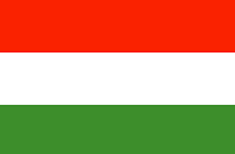Hungary Key Facts
-
Flag

-
Size
93,030 km²
-
Population
9.82 million
-
Hungary Location
Northern Europe
-
Travel Insurance
For Hungary travel insurance, select Europe Region
-
International Calling Codes
36
-
Cities
Budapest
Szeged
Debrecen -
Language
Hungarian
-
Religions
46% Other
37% Roman Catholic
12% Calvinist
2% Lutheran
2% Greek Catholic & Greek Orthodox
1% Jewish
-
Currency
-
Driving
In Hungary they drive on the right side of the road
Tourism website:
gotohungary.com
When is the best time to visit?
April to June and September to October are the best months to travel to Hungary.
- Holidaymakers have gone home; prices drop.
- Spring is glorious everywhere, though it can be pretty wet in May/early June.
- Autumn is particularly special in the hills (eg Bükk and Mátra); festivals mark the szüret (grape harvest).
Transport Information
There are no scheduled flights within Hungary. Hungary is small enough to get everywhere by train or bus within the span of a day.
World Heritage Sites
- Budapest, including the Banks of the Danube, the Buda Castle Quarter and Andrássy Avenue
- Early Christian Necropolis of Pécs (Sopianae)
- Fertö / Neusiedlersee Cultural Landscape
- Hortobágy National Park - the Puszta
- Millenary Benedictine Abbey of Pannonhalma and its Natural Environment
- Old Village of Hollókő and its Surroundings
- Tokaj Wine Region Historic Cultural Landscape
- Caves of Aggtelek Karst and Slovak Karst
Climate Information
In Hungary, Summer is warm, sunny and unusually long everywhere. Many cities grind to a halt in August, the 'cucumber-growing season' when nothing much else is happening. November is rainy; winter is cold and often bleak. Many sights reduce their hours sharply or close altogether.
Official Holidays
- 1 January - New Year’s Day
- 15 March - 1848 Revolution/National Day
- March/April - Easter Monday
- 1 May - International Labour Day
- May/June - Whit Monday
- 20 August - St Stephen’s/Constitution Day
- 23 October - 1956 Remembrance Day/Republic Day
- 1 November - All Saints’ Day
- 25 & 26 December - Christmas holidays
Why Visit Hungary?
Hungary has a lot to offer fresh-air fiends, from excellent hiking, canoeing, kayaking, horseback riding, hiking and fishing, to more contemplative pursuits. The country's many varied ecosystems make it a good birding destination, while spas and thermal springs are great for postactivity unwinding.
Things To Do In Hungary
-
Budapest’s nightlife simply has no rival among other European cities. Along with bars, pubs, dance halls and classic concert venues, Budapest has unique romkocsmák (ruin pubs) and kertek (gardens) that pop up all over town in the warmer months.
-
The 'city of healing waters' has enough thermal baths to satisfy the most wanton of appetites for wet fun. Some date back to the Turkish occupation, others are likened to swimming in a cathedral. If you want to splash in an outdoor whirlpool, there's plenty of that too.
-
Besides being home to Europe’s largest and most splendid synagogue, Budapest has seen a resurgence of Jewish culture, music and cuisine. On the sombre end of the spectrum, the Jewish ordeal of WWII is well documented in the Holocaust Memorial Center.
Travel Tips For Hungary
Hungarian National Tourist Office Has a chain of some 130 tourist information bureaus called Tourinform across the country. They are usually the best places to ask general questions and pick up brochures – and can sometimes provide more comprehensive assistance.
Budapest Tourism produces plenty of handy information about the capital and its attractions.
Hungarian Food
Hungary has an ever-increasing range of eating options, particularly in Budapest. In most places, it's fine to book on the day or not book at all; for fine dining in Budapest, book a week or two ahead.
- Restaurants Range from cheap Hungarian to refined sushi and Michelin-starred fine-dining establishments.
- Vendéglő Regional restaurants typically serving inexpensive homestyle cooking.
- Cafes Open during the daytime, these are great for coffee, cake and light (and sometimes substantial) meals.
- Csárda Typically rustic places serving large portions of Hungarian cuisine, often accompanied by Gypsy music.
Hungary Travel Safety and Warnings
- Pickpocketing is common at popular tourist sights, inside foreign fast-food chains, near major hotels and in flea markets. Sometimes pickpockets work together, with one distracting you by running into you and then apologising profusely – as an accomplice takes off with the goods.
- Thefts from rental vehicles are not uncommon. Don’t leave anything of value, including luggage, inside the car. This is a rare occurence these days, but occasionally waiters may make a ‘mistake’ when tallying the bill, or add service to the bill and then expect an additional tip. If you think there’s a discrepancy, ask for the menu and check the bill carefully.
- There are isolated incidents of taxi drivers, particularly in Budapest, taking advantage of passengers unfamiliar with local currency – switching large denomination notes for smaller ones and demanding extra payment. Only ever take taxis from reputable companies and make sure you know exactly how much cash you're handing over. Reputable ones include Budapest Taxi and Fő Taxi.
City Profile: Budapest
Did you know that the Hungarian capital is bisected by the Danube River, with “Buda” on the west bank and “Pest” on the east? Fancy a bit of Roman, Turkish, Gothic, Renaissance, Baroque, Classicist, Art Nouveau and Bauhaus architecture all in the one place? Castle Hill, located in Buda is a UNESCO World Heritage Site, which has the 700 year old Matthias Church, the Royal Palace and homes from the Middle Ages. Make sure you also visit Vaci St, a designated pedestrian precinct, and also Obuda, the oldest district in Budapest, which offers Roman ruins, monuments and museums. And as they have more thermal springs than any other capital city in the world, you can sight see to your heart’s content, and then take a relaxing dip in a Turkish bath (pictured) dating back to the 16th and 17th centuries.


